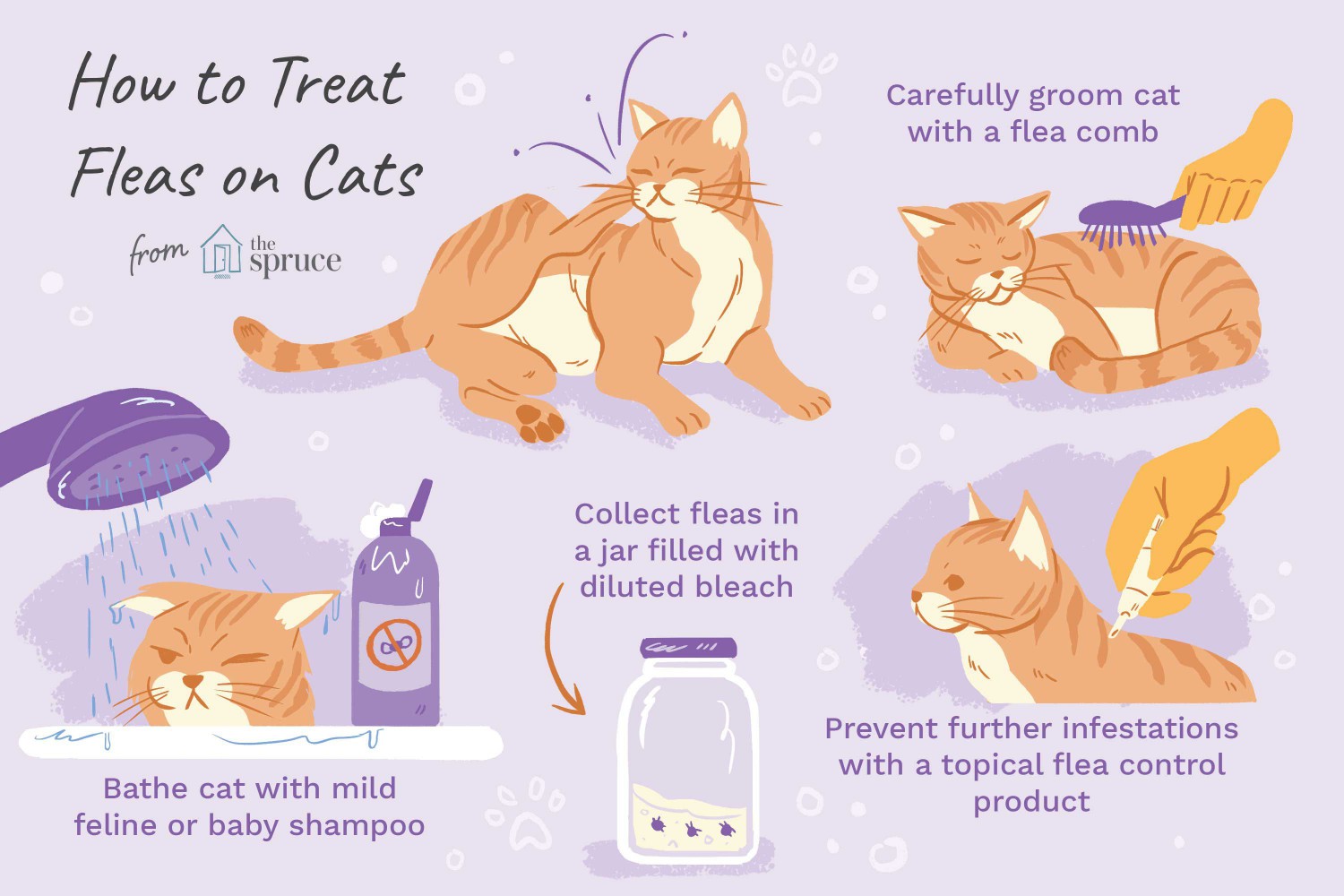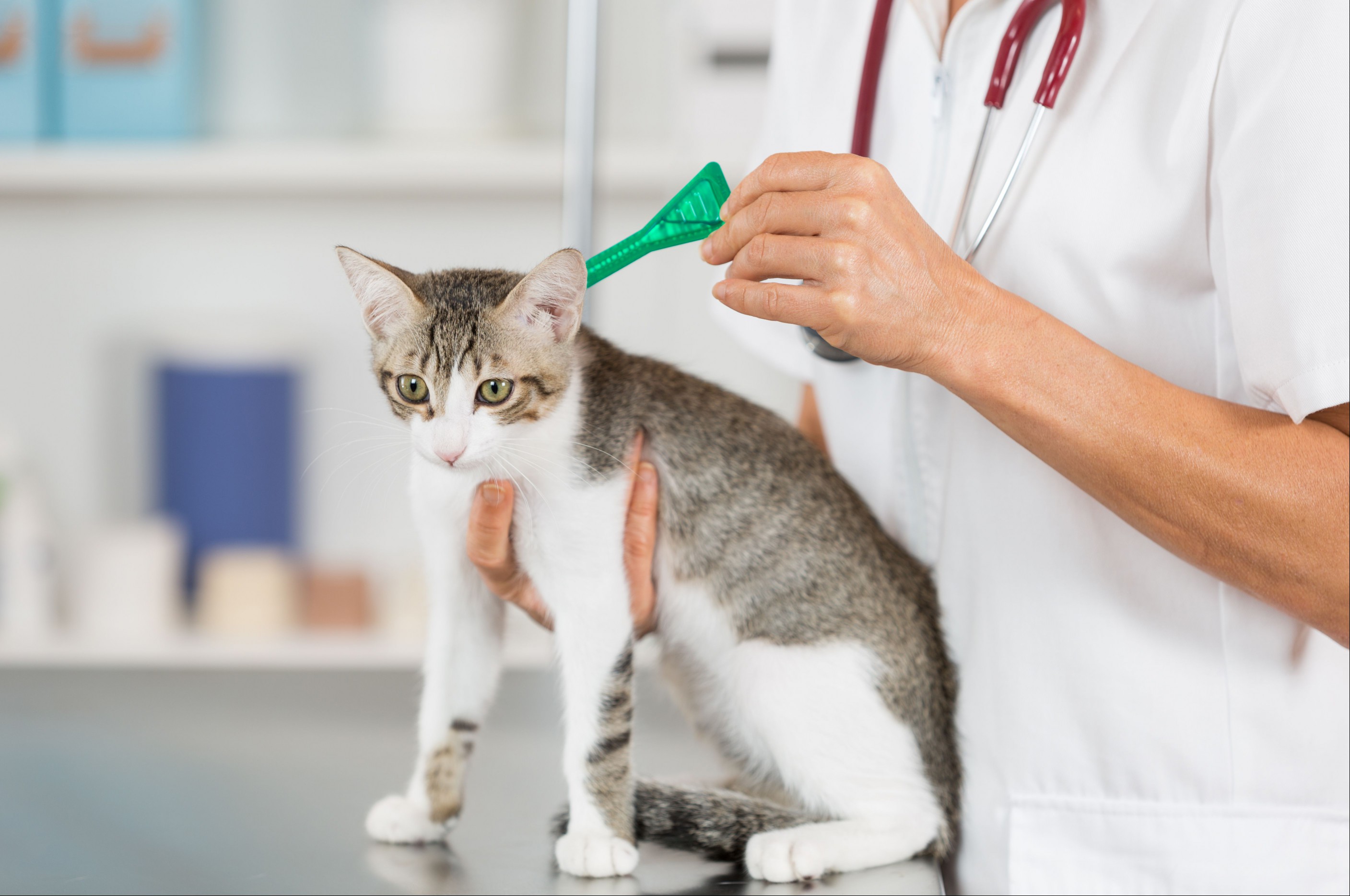Cat fleas are tiny parasites that feed on the blood and cause itching and irritation. Heavy flea infestations and allergic reactions to flea bites can lead to hair loss and open wounds. Worse yet, cat fleas can transmit dangerous diseases to cats and humans.
Here's what you need to know about fleas and your cat, including detection, treatment, and prevention.
What Are Fleas?
Fleas are tiny parasitic insects that eat the blood of mammals and birds. While there are over 2,200 species of fleas, the cat flea, Ctenocephalides felis felis, is the species that most commonly affects cats and dogs. Their flat bodies and strong legs make it easy for fleas to jump on a host and crawl through the fur, feeding on the host's blood along the way.
Flea Life Cycle
An adult female flea can lay 20 or more eggs per day. When eggs hatch, the larvae feed on flea excrement on the cat and in the environment for several days. They then form a protective cocoon and enter the pupal stage, where they'll mature until they emerge as adults. Flea pupae are hardy and can resist insecticides; they can remain dormant in the environment for days, weeks, or even months until a suitable host is available.
What Types of Diseases Can Fleas Transmit?
Fleas are known to carry several pathogens, some of which can affect both cats and humans:
- Tapeworms are intestinal parasites that cats can get from ingesting fleas, but they rarely affect people.
- Cat scratch disease is an infection caused by the bacteria Bartonella henselae. Cats don't typically get sick from this, but they can transmit the bacteria to humans through a scratch or bite.
- Plague is caused by the bacterium Yersinia pestis, carried by rodent fleas. Cats are not ideal hosts for these fleas, but it's still possible for them to transmit plague to you or your cat.
- Flea-borne (murine) typhus is caused by the bacteria Rickettsia spp., which can be found in cat fleas. Little is known about its effect on cats, but it can cause illness in humans.
Symptoms of Fleas in Cats
Fleas don't always cause obvious signs in cats, but itching and skin irritation will develop when a cat is allergic or sensitive to flea saliva. Common signs of fleas on cats include:
- Scratching
- Excessive grooming
- Red bites or scabs
- Hair loss
- Flea dirt (excrement that looks like black specks) on the skin, fur, or bedding
- Skin infection
If you observe your cat scratching and aren't sure if fleas are the cause, you can use your fingers or a flea comb to look for scurrying fleas or flea dirt in the cat's fur, especially around the head, neck, and base of the tail.
If you do not see fleas or flea dirt, it does not necessarily mean your cat is flea-free. Some cats will ingest fleas and flea dirt while grooming, making it difficult to spot the signs of a flea infestation.
In addition to skin irritation, cats can contract flea-borne illnesses or suffer anemia from blood loss. Flea anemia is more common in kittens with large numbers of fleas.
What Causes Fleas on Cats?
Outdoor cats encounter fleas in the environment, and because they are natural hosts for these parasites, they collect them during normal activity. Indoor cats can attract fleas that have hitched a ride into the home on other pets or people. Certain factors may increase the odds of a cat attracting fleas, including:
- Moist, wooded surroundings
- Long grass
- Indoor flea infestation (carpets, bedding)
- Neighboring flea problems (especially in apartment complexes)
- Moving to a new home that previously had fleas (pupae may suddenly emerge and infest)
How Do Vets Diagnose Flea Infestations?
Fleas are typically diagnosed by sight. A veterinarian will part a cat's fur to look for adult fleas or flea dirt. If a cat has a very low number of fleas, other issues like the presence of tapeworm segments in a cat's stool will alert the veterinarian that fleas are present.
How to Treat Cats With Fleas
First, realize that treating fleas requires a comprehensive approach. You must address all flea life stages as well as the environment. You can try to eliminate as many fleas as you can from your cat by combing through the fur with a flea comb or bathing your cat.
Bathing can help remove adult fleas and flea dirt but don’t force it if your cat refuses. If using a flea comb, deposit the fleas in soapy water so they don't escape back into the environment.
Most importantly, consult your veterinarian to determine the best and safest flea control product for your cat. Several oral and topical flea control products are on the market and new products come out regularly.
Warning
Never use a dog flea product on a cat. Many dog flea control products are toxic to cats and can cause severe illness in cats, including seizures and even death.
A flea infestation can be a challenge to manage because complete eradication requires a multifaceted approach:
- All household pets need to be treated with an effective flea control product.
- The home environment must also be treated for fleas.
It can take several months of treatment (both on the cat and in the home) to get rid of a flea infestation. Stopping treatments too soon will likely cause fleas to rapidly reemerge.

Spruce Pets / Theresa Chiechi
How Do You Get Rid of Fleas at Home?
As part of the flea treatment process, you must remove fleas and their eggs from your home to prevent reinfestation. To do this effectively, you will need to:
- Wash all bedding thoroughly in hot water if possible. While the bedding is free of coverings, vacuum the mattress, particularly in crevices where eggs can settle.
- Vacuum carpeting daily and dispose of used vacuum bags.
- Steam-clean carpeting to kill any remaining eggs.
- In some cases, you may need to hire a professional exterminator. Be sure to discuss the products they use to ensure that they are pet-safe.
Prognosis for Cats with Fleas
Once your flea problem is in check, cats will generally recover well as their itchiness subsides, wounds heal, and hair regrows.
If a cat has suffered a longstanding or particularly severe case of fleas, they may be anemic or carry a flea-borne disease that also requires treatment to achieve full recovery.
How to Prevent Cat Fleas
To keep fleas away, your cat should be treated with a vet-approved flea control product all year long. Most flea preventatives are labeled for once-monthly use. Although flea issues can be more severe in the warmer months, most vets recommend year-round prevention, especially if your cat has had fleas once before. The concern for diseases may warrant year-round prevention as well.
If you have multiple dogs or cats in your home, they must be all on prevention. Due to the life cycle and longevity of fleas, you'll never be able to get rid of your flea problem in your home if you leave one of your pets unprotected.

Are Fleas Contagious to Other Animals?
Fleas will happily leap from one animal to another, infesting all of the warm-blooded creatures in a household. While they aren't able to reside on humans as easily as furry pets, they will bite people and cause itching. Many flea-borne diseases can be transmitted from fleas to cats, dogs, humans, and other pets in a household, such as ferrets or birds.
Related Article

How to Stop a Cat From Attacking Its Tail
Question: "Why does my cat attack her tail?" Marlene, Jessica, and Dustin live with the

Cats and Obsessive Compulsive Behaviors
You may have heard of obsessive-compulsive disorder, but did you know cats can have forms of this d

How to Clicker Train Your Cat
Some nay-sayers will grumble that cats cannot be trained. That is not true. Cats are extremely trai

Can Cats Eat Coconut?
A popular tropical summer staple, coconuts can be found in everything from pies to fruity warm-weat

What to Expect When Your Cat Is in Heat
Cats in heat don't usually bleed or have periods the way humans do, but they experience several

Lily Toxicity in Cats
Lilies are sometimes grown in the garden or as houseplants, but the most common presentation is in

Dry Skin in Cats
Dry skin in cats can lead to flakiness, dandruff, itchiness, and general discomfort. It can also ma

Kidney Disease in Cats: Causes, Symptoms, and Treatment
Kidney disease is a general term for many conditions that may affect kidney function in cats. The m
About FleaFree Feline
We are a premier digital platform committed to delivering high-quality content to our readers. Our mission is to provide accurate, reliable, and engaging information that adds value to our audience's daily lives.
Our team consists of experienced content creators and subject matter experts who uphold the highest standards of professionalism. In an era of information overload, we curate content with care, ensuring our users receive only the most relevant and trustworthy information.
Beyond just reporting facts, we focus on depth and context. Through expert analysis, comprehensive research, and clear presentation, we help our audience gain meaningful insights and make informed decisions.
We take pride in being a trusted information source for our growing community of readers. Our user-first approach means we continuously adapt to provide content that meets our audience's evolving needs and interests.
Innovation and excellence drive everything we do. We're committed to improving our platform and services to deliver the best possible experience for our users.


Comments on " Cat Fleas: Treatment and Prevention" :